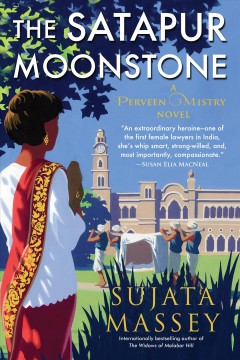The Satapur Moonstone is the second in a series by Sujata Massey about a female lawyer in India circa 1921. Although Perveen Mistry is fictional, she is based on “two women lawyers in India who practiced between the 1890s and into the 1930’s.”[i] For our readers, the historical setting and period details are both the most appealing and off-putting elements of the novel. We all agreed that it was tedious to look up so many words and many of us did not discover the glossary until too late! Our discussion included the usual first response, ease of reading, inquiry into character development, believability, and associations – personal and fictional.
I started the meeting by reviewing materials we have available through the library to further our understanding of the setting, as well as to showcase some of the author’s historical accuracy. One of her references is to a collection of letters written by E.M. Forster, the author of A Passage to India who served as secretary to the Maharajah of Dewas Senior in 1921. Forester’s The Hill of Devi describes a similar world to that of The Satapur Moonstone as a primary resource rather than fiction!
All of us at the meeting liked the book. Our first responder was particularly moved by reading about India at the same time we have been inundated with news coverage of the devastation Covid is wreaking there.[ii] She also has been watching The Resident, and the book increased her understanding of the television character Devon Pravesh. Another member finds that reading about different cultures has always shown her that people everywhere are not having the same experiences and helps her appreciate what she has. When we discussed crowds, one of us mentioned how when visiting India he found you could never be alone. This is another reason why personal memories triggered by associations with books are an important aspect of our book club, in addition to shared experiences of the same books.
We touched on the Indian caste system and the limited opportunities for the Anglo-engineer character to fit into either the Indian or the British Royal world, as well as the impact of so many religions. How did they have parties while practicing Purdah? We looked at the distances travelled, carried in a palanquin, the lack of access to roads and transportation keeping people trapped in the palaces as much as did their caste. We also discussed the increased interest in genealogy because of DNA testing. One of our member’s grandsons had assumed that he was of Mexican heritage but was excited to learn that he is nearly a quarter Native American. Understanding ancestry, like a glass half full or half empty, depends on the perspective. This was not said in the meeting, but it seems apropos.
Although those of us at the meeting found the story compelling to read, we didn’t quite understand how both the doctor and the grandmother accepted that the young maharajah was killed by a tiger. We liked the young princess, her and her mother’s ways of getting what they wanted in a world that limited them, that could not allow them a compliment if the chosen son did not receive a better one first. One of us thought the story was like Beauty and the Beast: the palace was gay and full of life before the curse that killed the Maharajah and trapped them until the mystery was solved and the evil vanquished! We did not discuss the romance, which was definitely left as a teaser for the next book, The Bombay Prince.
We met on the stage again and I didn’t turn on the overhead lights in order to keep it cooler, but the shadowy atmosphere seemed stuffy and grim. Although we no longer have limits on attendance or social distancing, and vaccinated attendees do not need to wear masks unless they so choose, we still have not added snacks back into our meetings. I missed it here especially, since the setting is perfect for a taste of something exotic. I will add some of our emailed comments and hope you will continue the discussion!
- OTHER WORKS DIScUSSED:
- The Namesake (2003) by Jhumpa Lahiri
- The Resident (2018) television series
-
- A Passage to India (1924) by E.M. Forster (Book and Film)
- Maharanis: A Family Saga of Four Queens (2006) by Lucy Moore
- Ayurveda: The Ancient Indian Medical System, Focusing on Prevention of Disease Through Diet, Lifestyle and Herbalism (2013) by Gopi Warrier
- Ayurveda for Modern: a Practical Guide to Understanding & Nourishing Your Body (2020) by Eminé Ali Rushton
[i] Excerpt from an interview: “Sujata Massey on Her New Novel, The Satapur Moonstone. Reading Women discuss 1920’s India and the woman lawyer who inspired the Perveen Mistry Series. By Reading Women – July 31, 2019.” Web access 5-8-2021: https://lithub.com/sujata-massey-on-her-new-novel-the-satapur-moonstone/.
[ii] Today’s, June 10th, CNBC headline: “India reports more than 6,000 daily Covid deaths — highest ever in the world.” https://www.cnbc.com/2021/06/10/india-covid-crisis-more-than-6000-deaths-recorded-in-24-hours.html
